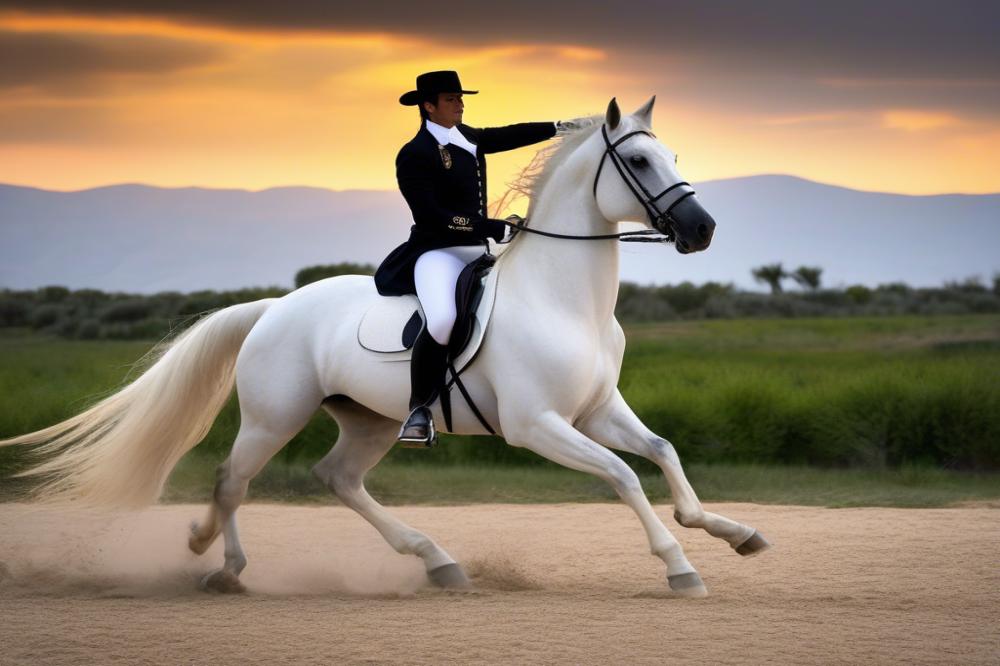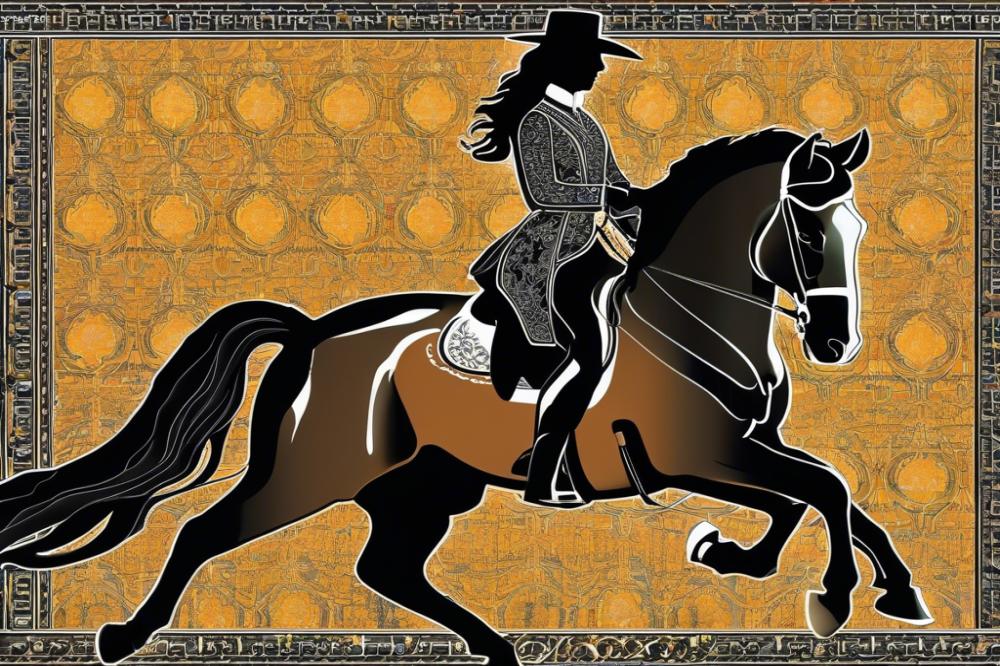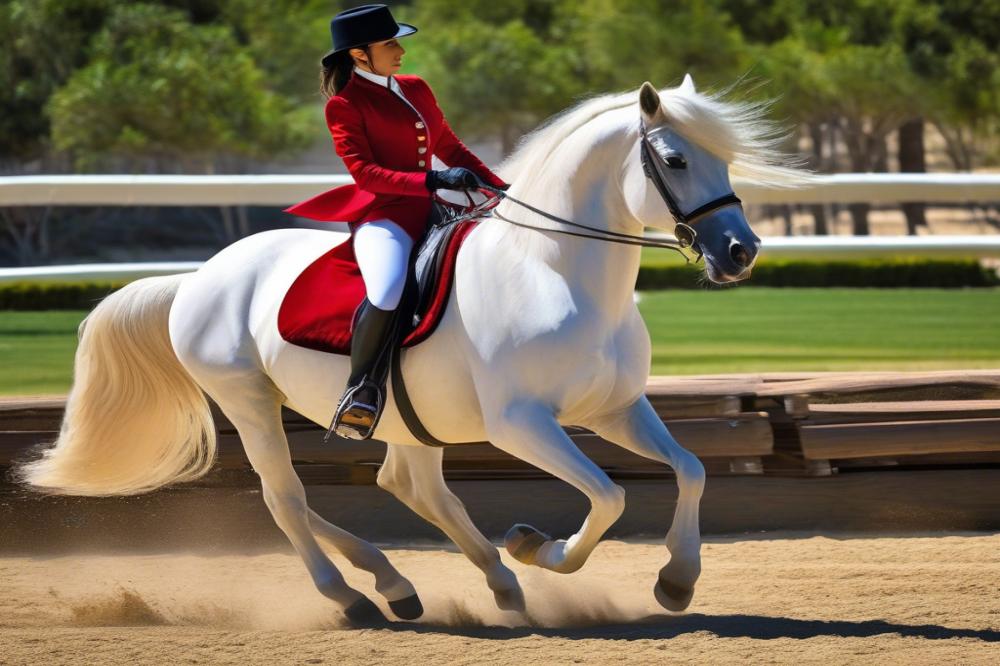Introduction
The Andalusian horse is known for its grace, strength, and spirited nature. This breed captures attention with its striking appearance and powerful movements. Riders are often drawn to these animals for their impressive capabilities. However, the energy of an Andalusian can be both a joy and a challenge. Managing that energy is crucial for a smooth experience during rides.
Horse riders must understand that energy control plays a vital role in effective riding. A horse that is overly energetic or excited can be difficult to handle. Conversely, a well-managed horse can respond beautifully to commands. This balance is essential not just for safety but also for performance. Riders who can harness this energy will enhance their riding experience.
This article aims to provide insights and practical tips for controlling the energy of an Andalusian horse while riding. Readers will learn about key techniques to manage their horse’s enthusiasm. Understanding these aspects will make every ride more enjoyable and productive. Getting a handle on horse riding techniques is pivotal for success and harmony in riding sessions. With the right approach, riders can connect with their horses on a deeper level.
Understanding the Energy of an Andalusian Horse

The Andalusian horse is known for its spirited nature. Often described as confident and intelligent, this breed displays a lively temperament. Riders must grasp the essence of their energy to cultivate a harmonious relationship. Understanding these characteristics can greatly improve the riding experience.
Natural energy levels in these horses can vary. Some individuals possess a more exuberant spirit. Others may be calmer but still exhibit a keen sense of alertness. This range of energy influences how they respond to commands and environmental stimuli. Riders should not underestimate how this energy can change based on their mood or surroundings.
When considering how energy affects performance, different riding disciplines come into play. In dressage, a well-controlled energy can highlight a horse’s elegance and precision. Conversely, in jumping, raw energy can translate into speed and agility. Knowing how to channel this energy is vital. Good energy management can lead to success in competitions and improve everyday riding.
Behavior also plays a significant role. An excited Andalusian may fidget or prance, indicating a buildup of energy. It’s essential for riders to remain calm, providing reassurance. This tranquil approach can help to relax the horse while maintaining an appropriate level of engagement. Techniques like groundwork can be beneficial before mounting.
Recognizing when to encourage or temper a horse’s energy is key. For instance, during training, prompting the horse through cues can unleash their potential. In a competitive setting, it is crucial to create a focused atmosphere. Maintaining a balance fosters a connection that is both effective and enjoyable.
In summary, riders need to consider the unique characteristics of this breed’s temperament. Understanding the natural behaviors and energy levels will lead to more effective communication. Ultimately, adapting to these aspects can make riding a rewarding experience, whether for leisure or competition.
riding techniques for energy control

Managing the energy of your horse while riding requires specific techniques. Focused body position can make a significant difference. Sit up straight and keep your shoulders back. This helps maintain the horse’s balance and aligns your center of gravity. A balanced rider will not disturb the horse’s natural movement.
Rhythm plays an important role in energy control. Finding the right tempo can help create a harmonious connection between horse and rider. Change your pace smoothly; abrupt shifts can create tension. Instead, use breathing as a tool. Inhale during steady moments and exhale when increasing energy. This also helps the horse respond to your movements.
Effective use of aids is crucial for communication. Your legs can guide the horse without using too much energy. Lightly squeezing the sides encourages it to move forward. Conversely, shifting your weight back can signal a decrease in speed. Consistency in these cues builds trust over time.
Don’t forget the importance of posture. Keep your heels down and weight in your stirrups. This action stabilizes you in the saddle, which is key for managing energy levels. A stable rider will contribute to a more relaxed horse.
Lastly, mindfulness improves your riding practice. Stay aware of your surroundings and your horse’s reactions. Adjust your energy based on the situation to maintain control and harmony. With practice, these techniques will lead to a more enjoyable ride for both you and your horse.
Leadership in Riding

Establishing a leadership role is vital in equestrian training. A horse needs to recognize its rider as a guide. This recognition fosters trust and respect. When a bond forms, the horse tunes into the rider’s cues more effectively.
Building trust involves consistency in your actions. Being calm in the saddle helps your horse feel at ease. It is essential to communicate clearly and patiently. Patience will lead to understanding and cooperation over time.
Respect can grow when a rider sets boundaries. Use your body language to assert authority without being harsh. Stand tall and carry yourself confidently. A horse can sense uncertainty, so projecting calmness is key.
Techniques to help maintain control include using your voice. Soft commands can guide your horse’s movements. Reinforce positive behavior with praise. A gentle touch or a verbal cue can go a long way in nurturing a strong relationship.
During training sessions, focus on creating a safe environment. Horses thrive when they feel secure. Use consistent routines to help them know what to expect. Gradually introduce new exercises to build their confidence.
Practicing groundwork cultivates leadership skills. Groundwork builds communication skills and helps prevent misunderstandings. This can translate well when mounted. Reinforcing your position as the leader both on the ground and in the saddle creates a cohesive partnership.
Calm rides come from a respectful connection. A horse that trusts its rider is more relaxed. By adopting a leadership role, you can guide your Andalusian horse effectively. This will make every ride not only more manageable but also enjoyable.
Riding Exercises for Energy Management
Controlling the energy of a spirited horse requires practical and thoughtful exercises. Groundwork is one of the best places to start. Engaging with your horse on the ground allows for better communication and understanding. It’s all about creating a bond and promoting awareness of energy levels. Start with basic lunging. This helps your horse learn to listen to you while getting some energy out.
Consider incorporating pattern work while lunging. Use cones or markers to create a layout. This method teaches your horse to focus and stay directed. Changing directions often keeps him engaged, which can reduce excess energy. Reinforce calm behavior with praise to build confidence. Remember, energy management isn’t only about control; it’s also about connection.
Transitioning to riding requires thoughtful drills. One effective approach is to practice circles. Push your horse to develop rhythm and balance. This exercise encourages him to be responsive to your cues. If he starts to speed up, gently bring him back with your seat and legs. Consistency is key. Using changes in pace can also help. Alternating between walk, trot, and canter creates a rhythm that helps in energy distribution.
Implement small figure eights during your ride. This encourages bending and flexibility while keeping your horse engaged. The change of direction requires him to focus on your cues. Keep the energy manageable by rewarding soft responses immediately. As you ride, focus on your breathing. Deep breaths can help both you and your horse center yourselves.
Don’t forget to include transitions in your routine. For instance, shifting from trot to walk can be a calming exercise. Use these moments to reinforce your connection. Be patient. Allow your horse to learn how to settle into his rhythm. Resilience builds with time and training.
A good final exercise is to practice riding with varying speeds. Begin at a slow pace, then build to a faster one, and return to a slower speed. This cycle teaches your horse to listen and respond to your cues. Stay aware of his energy shifts. He may need to stop or slow down. Read the signals he gives you.
In all these exercises, remember that awareness is vital. Pay attention to how your horse is feeling. This understanding fosters trust and improves overall communication. Riding should feel like a partnership. Use each ride as an opportunity to enhance your skills and your horse’s responsiveness.
Understanding Horse Behavior for Better Communication
Recognizing the behavior of the Andalusian horse is essential for effective riding. These horses are known for their sensitivity and responsiveness. Many riders admire their grace, but it is important to appreciate how their mindset affects performance.
Key traits include a strong desire for engagement with their riders. They can also be somewhat reactive. When a rider feels tension or excitement, the horse often mirrors those emotions. It’s crucial to be aware of the horse’s body language and mood.
Signs of stress can appear in various ways. Look for rapid breathing or pinned ears. An anxious horse might paw the ground or move in place. Understanding these signs helps you intervene calmly before the situation escalates.
Also, excess energy can lead to issues during a ride. A horse may buck or bolt when feeling overwhelmed. Recognizing when your horse is too energetic can prevent dangerous situations. Pay attention to any sudden changes in behavior.
Strategies for Improving Communication
A few strategies enhance the communication between horse and rider. Start with clear cues and consistent signals. Horses thrive on predictability. Providing them with a stable routine can reduce anxiety.
Breathing patterns can also affect the horse’s energy. Take deep, slow breaths before and during your ride. This can help lower the horse’s tension while establishing a calming atmosphere. Encouraging relaxation in yourself can lead to relaxation in your horse.
Positive reinforcement is another valuable tool. Rewarding desired behaviors with treats or praise fosters trust. This builds a bond between horse and rider. A solid relationship allows the horse to feel secure in your presence.
Gradually introduce challenges during training sessions. Horses often benefit from small obstacles that help manage their energy. Each success will boost their confidence. This approach creates a positive feedback loop, reinforcing good behavior.
Lastly, patience is vital when working with an Andalusian. Rushing can lead to misunderstandings. Take your time to understand your horse’s needs. Building that rapport can significantly improve your experience together.
Calm Riding Strategies
Maintaining calmness while riding is essential for effective control. A relaxed rider communicates better with the horse. Stress or tension can lead to confusion. The initial step involves your own mindset. Before mounting, take a moment to breathe deeply. This simple act can center your thoughts.
Hands should be soft on the reins. A tense grip can signal anxiety to your Andalusian horse. Rather than pulling or yanking, use gentle nudges to guide. Adjust your seat to follow the horse’s movements. This technique creates harmony between you and the horse.
Breath management plays a crucial role in relaxation. Focus on slow, deliberate inhalations and exhalations. As you ride, synchronize your breath with the rhythm of the horse. This practice can foster a sense of calm and connection.
Mindfulness is another powerful tool for riders. Stay present and aware of your surroundings during your ride. Recognize the energy of your horse without judgment. Acknowledge how your own emotions may affect the ride. If you feel tension building, pause for a moment. Use that time to refocus on your breathing.
Developing a mantra can also help during rides. A phrase like “stay calm” can be a useful reminder when anxiety creeps in. Repeat it silently to reinforce your focus. Your body will follow your mind. This creates a ripple effect that promotes tranquility.
Incorporating short breaks into your ride can enhance your experience. Step back from the trot or canter to walk for a while. This shift in pace allows both you and your horse to regroup. It prevents the buildup of excess energy that may lead to a tense situation.
Practice makes perfect. The more you focus on your calmness, the easier it becomes. Remember, it’s about building a partnership. Take time to understand your horse’s behaviors and reactions. Patience is vital in achieving harmony. You will likely see improvement as this bond strengthens.
Riding Tips for Effective Equine Energy Management
Riding an Andalusian horse requires understanding its energy levels. Different situations call for varied approaches to maintain control. Here are some practical tips that can help.
Start with a calm demeanor. Horses often pick up on their rider’s emotions. If you remain relaxed, your mount is more likely to feel the same. Use consistent voice commands. This helps create familiarity and builds trust during your time together.
Adjust your riding style based on the scenario. In confined spaces, gentle pressure can assist with maintaining focus. Instead of pulling back on the reins, try to use your legs. A light squeeze may guide them without stifling their spirit.
On open trails, energy can surge. Embrace this by allowing for a balanced forward movement. Resist the urge to hold them back, as this may lead to frustration. Instead, redirect their excitement into a productive stride.
When practicing transitions, incorporate changes in rhythm. Slow down before a turn and then speed up after. This teaches the horse to respond to your cues with precision. Frequent practice solidifies these lessons, making them second nature.
Consistency is crucial for developing a good working relationship. Establish a routine that both of you can rely on. Routine training sessions help build muscle memory. Skills improve as both rider and horse grow more comfortable together.
Finally, patience cannot be overstated. Every horse has its own pace of learning. Celebrate small achievements, as this will encourage further progress. Riding is a partnership built on trust and understanding.
Final Thoughts on Energy Control in Riding
Building a successful partnership with your horse involves understanding energy control. The techniques discussed throughout this article focus on balance, communication, and rhythm. By becoming more aware of your own body language and how it affects your horse, you set the stage for effective riding.
Riders must practice these methods regularly. Consistency is key. Each session provides an opportunity to refine skills and deepen the bond between rider and horse. Focus on maintaining a calm demeanor. This will positively influence your horse’s behavior and reactions.
Developing this partnership takes time and effort. Many riders may find it challenging at first. However, persistence yields rewarding results. equestrian training is an ongoing journey that requires patience.
As you ride, remember to embrace the uniqueness of each horse. Every animal has its own personality and energy. Adapting your approach to match your horse’s needs can create an amazing connection. Seek to understand their moods and energy levels. Over time, this enhances your ability to ride more effectively.
In summary, mastering energy control is essential for successful riding. Practice the techniques you’ve learned. Always strive for improvement. With dedication, you will foster a harmonious relationship with your horse, enriching both your riding experience and your equestrian journey.



